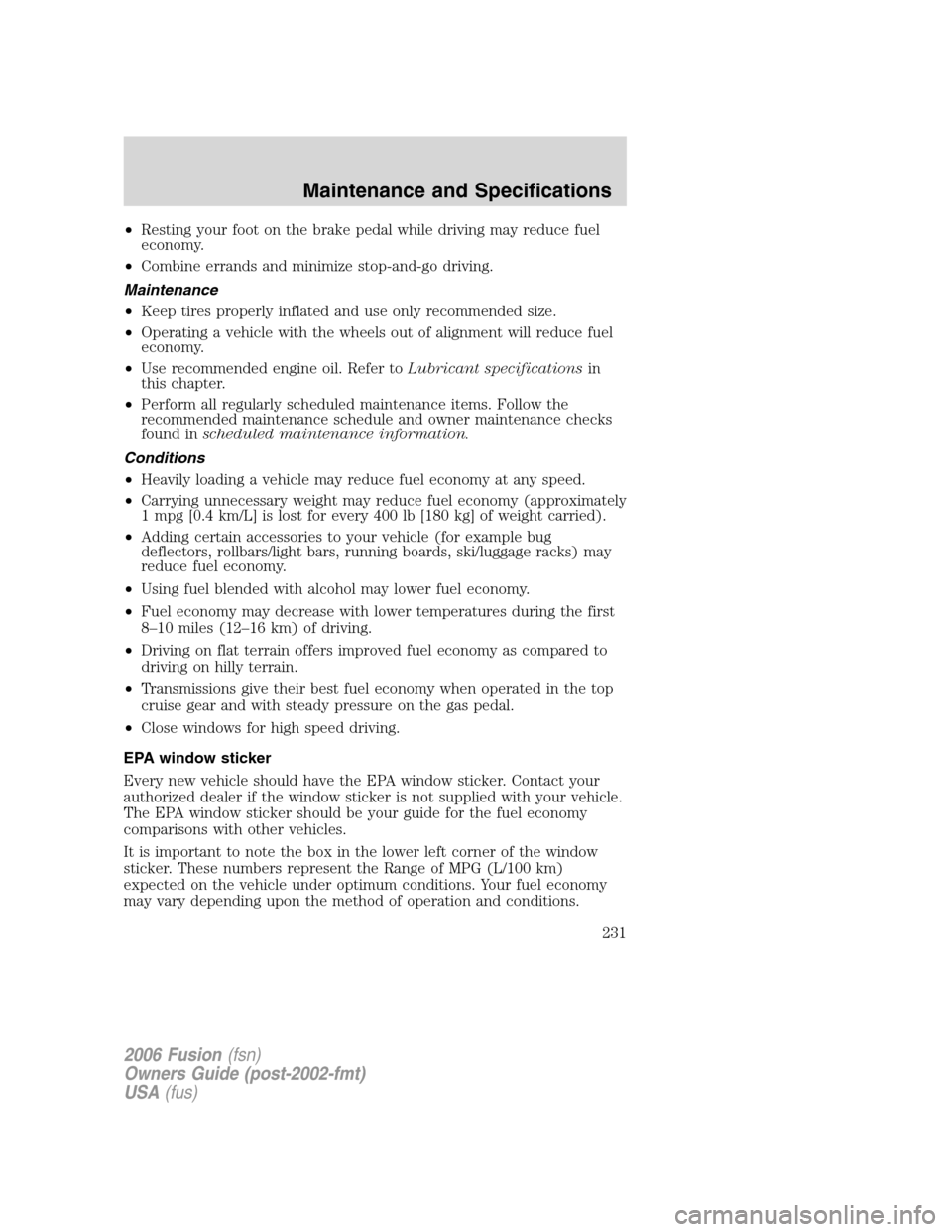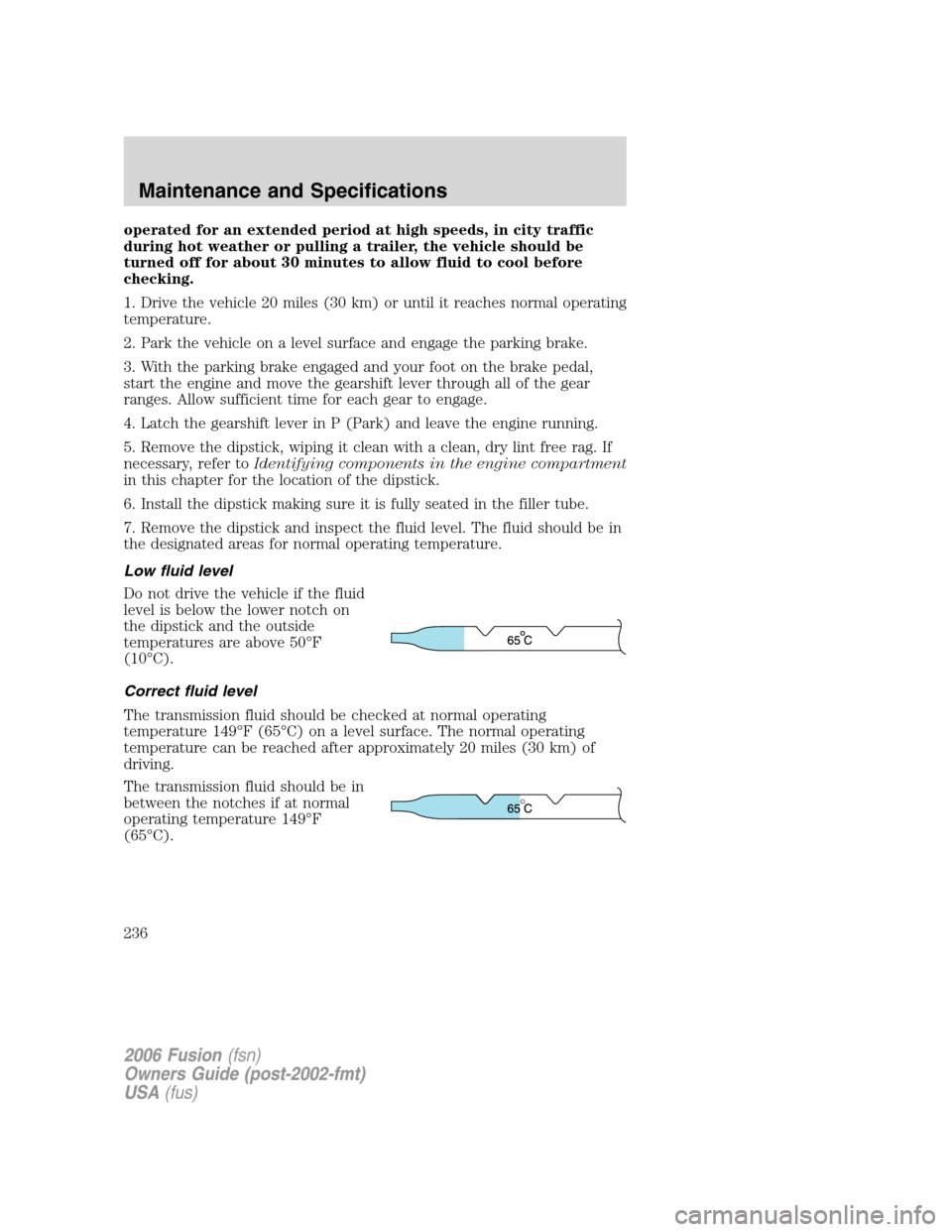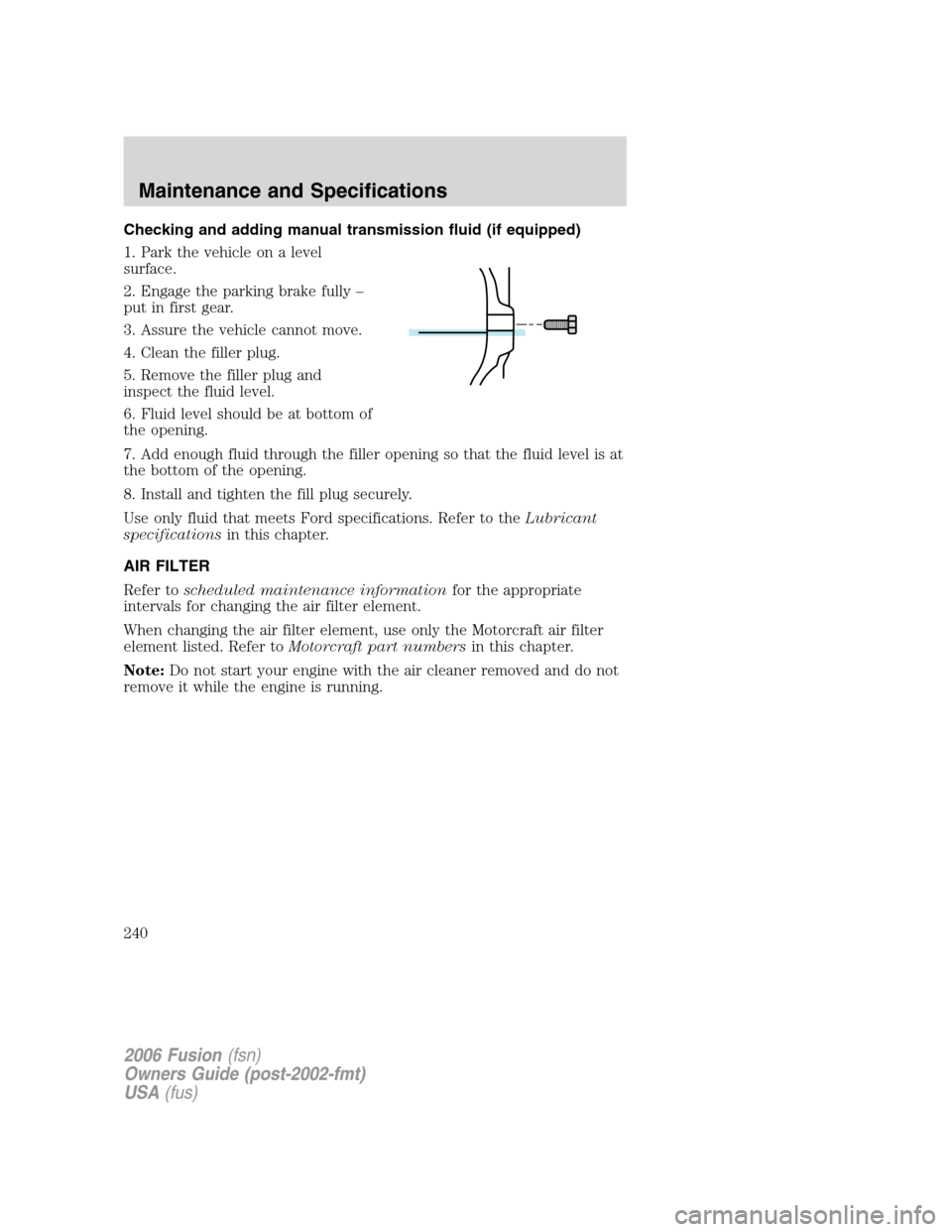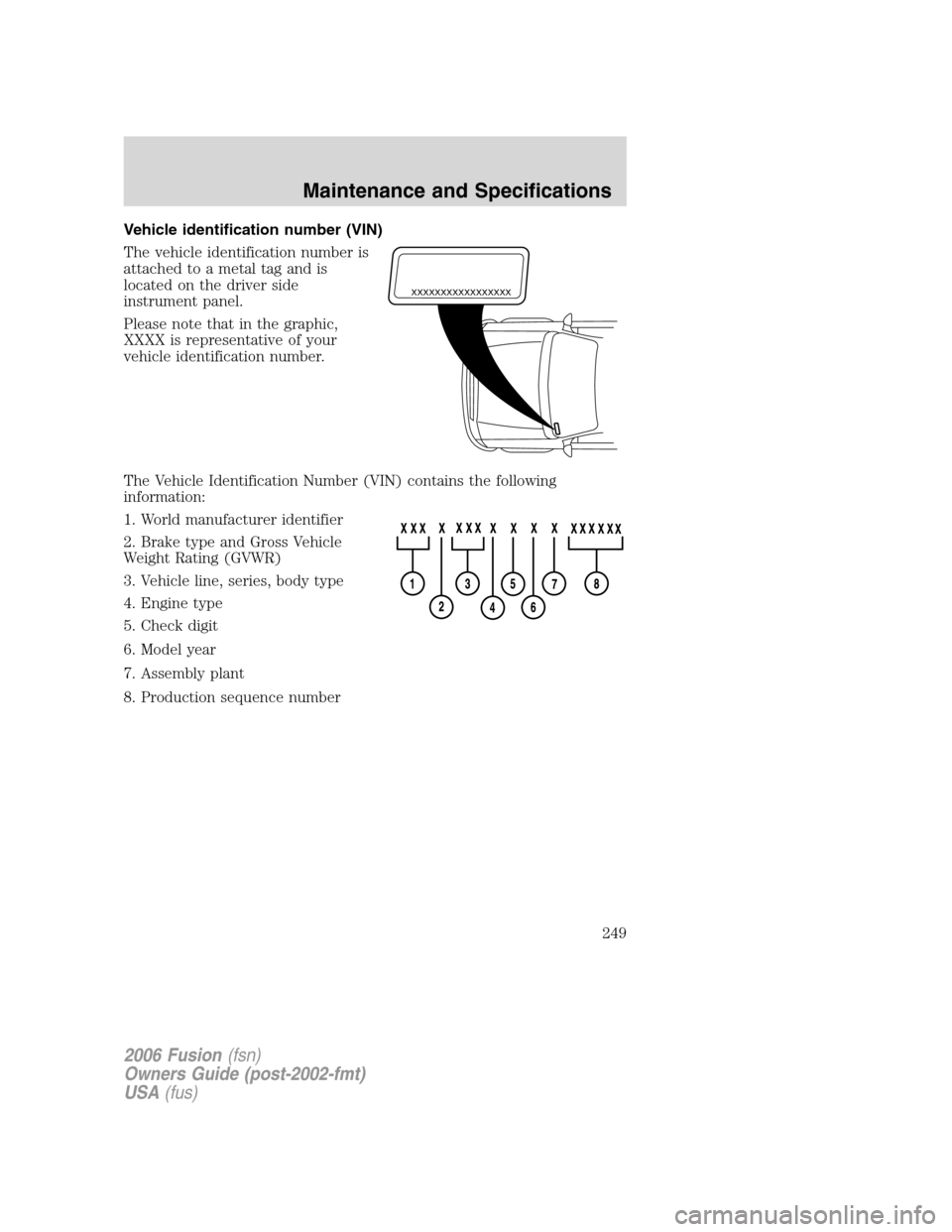2006 FORD FUSION (AMERICAS) check engine
[x] Cancel search: check enginePage 231 of 264

•Resting your foot on the brake pedal while driving may reduce fuel
economy.
•Combine errands and minimize stop-and-go driving.
Maintenance
•Keep tires properly inflated and use only recommended size.
•Operating a vehicle with the wheels out of alignment will reduce fuel
economy.
•Use recommended engine oil. Refer toLubricant specificationsin
this chapter.
•Perform all regularly scheduled maintenance items. Follow the
recommended maintenance schedule and owner maintenance checks
found inscheduled maintenance information.
Conditions
•Heavily loading a vehicle may reduce fuel economy at any speed.
•Carrying unnecessary weight may reduce fuel economy (approximately
1 mpg [0.4 km/L] is lost for every 400 lb [180 kg] of weight carried).
•Adding certain accessories to your vehicle (for example bug
deflectors, rollbars/light bars, running boards, ski/luggage racks) may
reduce fuel economy.
•Using fuel blended with alcohol may lower fuel economy.
•Fuel economy may decrease with lower temperatures during the first
8–10 miles (12–16 km) of driving.
•Driving on flat terrain offers improved fuel economy as compared to
driving on hilly terrain.
•Transmissions give their best fuel economy when operated in the top
cruise gear and with steady pressure on the gas pedal.
•Close windows for high speed driving.
EPA window sticker
Every new vehicle should have the EPA window sticker. Contact your
authorized dealer if the window sticker is not supplied with your vehicle.
The EPA window sticker should be your guide for the fuel economy
comparisons with other vehicles.
It is important to note the box in the lower left corner of the window
sticker. These numbers represent the Range of MPG (L/100 km)
expected on the vehicle under optimum conditions. Your fuel economy
may vary depending upon the method of operation and conditions.
2006 Fusion(fsn)
Owners Guide (post-2002-fmt)
USA(fus)
Maintenance and Specifications
231
Page 235 of 264

1. Start the engine and let it run until it reaches normal operating
temperature (the engine coolant temperature gauge indicator will be
near the center of the normal area between H and C).
2. While the engine idles, turn the steering wheel left and right several
times.
3. Turn the engine off.
4. Check the fluid level in the reservoir. It should be between the
MIN/MAX or upper and lower lines. Do not add fluid if the level is in this
range.
5. If the fluid is low, add fluid in small amounts, continuously checking
the level until it reaches the range between the MIN/MAX or upper and
lower lines. Be sure to put the cap back on the reservoir.
BRAKE/CLUTCH FLUID
Brake and clutch systems are supplied from the same reservoir.
The fluid level will drop slowly as
the brakes wear, and will rise when
the brake components are replaced.
Fluid levels between the “MIN” and
“MAX” lines are within the normal
operating range; there is no need to
add fluid. If the fluid levels are
outside of the normal operating
range the performance of your
brake system could be
compromised; seek service from
your authorized dealer immediately.
TRANSAXLE FLUID
Checking 5–speed automatic transaxle fluid (If equipped)
Refer to yourscheduled maintenance informationfor scheduled
intervals for fluid checks and changes. Your transaxle does not consume
fluid. However, the fluid level should be checked if the transaxle is not
working properly, i.e., if the transaxle slips or shifts slowly or if you
notice some sign of fluid leakage.
Automatic transmission fluid expands when warmed. To obtain an
accurate fluid check, drive the vehicle until it is warmed up
(approximately 20 miles [30 km]). If your vehicle has been
MAX
MIN
2006 Fusion(fsn)
Owners Guide (post-2002-fmt)
USA(fus)
Maintenance and Specifications
235
Page 236 of 264

operated for an extended period at high speeds, in city traffic
during hot weather or pulling a trailer, the vehicle should be
turned off for about 30 minutes to allow fluid to cool before
checking.
1. Drive the vehicle 20 miles (30 km) or until it reaches normal operating
temperature.
2. Park the vehicle on a level surface and engage the parking brake.
3. With the parking brake engaged and your foot on the brake pedal,
start the engine and move the gearshift lever through all of the gear
ranges. Allow sufficient time for each gear to engage.
4. Latch the gearshift lever in P (Park) and leave the engine running.
5. Remove the dipstick, wiping it clean with a clean, dry lint free rag. If
necessary, refer toIdentifying components in the engine compartment
in this chapter for the location of the dipstick.
6. Install the dipstick making sure it is fully seated in the filler tube.
7. Remove the dipstick and inspect the fluid level. The fluid should be in
the designated areas for normal operating temperature.
Low fluid level
Do not drive the vehicle if the fluid
level is below the lower notch on
the dipstick and the outside
temperatures are above 50°F
(10°C).
Correct fluid level
The transmission fluid should be checked at normal operating
temperature 149°F (65°C) on a level surface. The normal operating
temperature can be reached after approximately 20 miles (30 km) of
driving.
The transmission fluid should be in
between the notches if at normal
operating temperature 149°F
(65°C).
2006 Fusion(fsn)
Owners Guide (post-2002-fmt)
USA(fus)
Maintenance and Specifications
236
Page 238 of 264
![FORD FUSION (AMERICAS) 2006 1.G Owners Manual Checking automatic transmission fluid at normal operating
temperature (140°F-158°F [60°C-70°C])
Automatic transmission fluid expands when warmed. To obtain an
accurate fluid check, drive the vehic FORD FUSION (AMERICAS) 2006 1.G Owners Manual Checking automatic transmission fluid at normal operating
temperature (140°F-158°F [60°C-70°C])
Automatic transmission fluid expands when warmed. To obtain an
accurate fluid check, drive the vehic](/manual-img/11/5179/w960_5179-237.png)
Checking automatic transmission fluid at normal operating
temperature (140°F-158°F [60°C-70°C])
Automatic transmission fluid expands when warmed. To obtain an
accurate fluid check, drive the vehicle until it is warmed up
(approximately 20 miles [30 km]) until the engine coolant gauge
indicates normal operating temperature. If your vehicle has been
operated for an extended period at high speeds, in city traffic
during hot weather or pulling a trailer, the vehicle should be
turned off for about 30 minutes to allow fluid to cool before
checking.
1. Drive the vehicle 20 miles (30 km) or until the coolant guage indicates
normal operating temperature.
2. Park the vehicle on a level surface and engage the parking brake.
3. With the parking brake engaged and your foot on the brake pedal,
start the engine and move the gearshift lever through all of the gear
ranges. Allow sufficient time for each gear to engage (approximately
10–15 seconds in each position).
4. Move the gearshift lever to P (Park) and leave the engine running.
5. Remove the dipstick, wiping it clean with a clean, dry, lint-free rag. If
necessary, refer toIdentifying components in the engine compartment
in this chapter for the location of the dipstick.
6. Install the dipstick making sure it is fully seated in the filler tube.
7. Remove the dipstick and inspect
the fluid level. The fluid should read
within the hot range on the dipstick
if at normal operating temperature
(140°F-158°F [60°C-70°C]).
Checking automatic transmission fluid at cool temperature
(59°F-77°F [15°C-25°C])
If a fluid check is necessary at a low
fluid temperature (59°F-77°F
[15°C-25°C]), perform the check
using the cold range on the dipstick.
However, the fluid must be
re-checked at the proper fluid temperature.
2006 Fusion(fsn)
Owners Guide (post-2002-fmt)
USA(fus)
Maintenance and Specifications
238
Page 240 of 264

Checking and adding manual transmission fluid (if equipped)
1. Park the vehicle on a level
surface.
2. Engage the parking brake fully –
put in first gear.
3. Assure the vehicle cannot move.
4. Clean the filler plug.
5. Remove the filler plug and
inspect the fluid level.
6. Fluid level should be at bottom of
the opening.
7. Add enough fluid through the filler opening so that the fluid level is at
the bottom of the opening.
8. Install and tighten the fill plug securely.
Use only fluid that meets Ford specifications. Refer to theLubricant
specificationsin this chapter.
AIR FILTER
Refer toscheduled maintenance informationfor the appropriate
intervals for changing the air filter element.
When changing the air filter element, use only the Motorcraft air filter
element listed. Refer toMotorcraft part numbersin this chapter.
Note:Do not start your engine with the air cleaner removed and do not
remove it while the engine is running.
2006 Fusion(fsn)
Owners Guide (post-2002-fmt)
USA(fus)
Maintenance and Specifications
240
Page 249 of 264

Vehicle identification number (VIN)
The vehicle identification number is
attached to a metal tag and is
located on the driver side
instrument panel.
Please note that in the graphic,
XXXX is representative of your
vehicle identification number.
The Vehicle Identification Number (VIN) contains the following
information:
1. World manufacturer identifier
2. Brake type and Gross Vehicle
Weight Rating (GVWR)
3. Vehicle line, series, body type
4. Engine type
5. Check digit
6. Model year
7. Assembly plant
8. Production sequence number
XXXXXXXXXXXXXXXXX
2006 Fusion(fsn)
Owners Guide (post-2002-fmt)
USA(fus)
Maintenance and Specifications
249
Page 254 of 264

A
Accessory delay ..........................53
Air cleaner filter ...............240–242
Air conditioning ....................29, 31
Airbag supplemental restraint
system ................107–108, 116, 119
and child safety seats ............109
description ..............108, 116, 119
disposal ....................................123
driver airbag ............110, 117, 121
indicator light .........116, 118, 122
operation .................110, 117, 121
passenger airbag .....110, 117, 121
side airbag .......................116, 119
Antifreeze
(see Engine coolant) ................218
Anti-lock brake system
(see Brakes) ......................160–161
Anti-theft system ........................85
arming the system ....................85
disarming a triggered system ..86
Audio system (see Radio) ...17, 21
Automatic transaxle
fluid, adding ....................235, 237
fluid, checking ................235, 237
Automatic transmission
driving an automatic
overdrive .........................165–166
fluid, refill capacities ..............243
fluid, specification ..................246
Axle
lubricant specifications ..245–246
B
Battery .......................................216
acid, treating emergencies .....216
jumping a disabled battery ....185maintenance-free ....................216
replacement, specifications ...242
servicing ..................................216
BeltMinder .................................102
Brakes ........................................160
anti-lock ...........................160–161
anti-lock brake system
(ABS) warning light ...............160
fluid, checking and adding ....235
fluid, refill capacities ..............243
fluid, specifications .........245–246
lubricant specifications ..245–246
parking ....................................161
shift interlock ..........................163
Break-in period .............................5
Bulbs ............................................39
C
Capacities for refilling fluids ....243
Cassette tape player ...................17
Cell phone use ..............................7
Changing a tire .........................179
Child safety restraints ..............123
child safety belts ....................123
Child safety seats ......................127
attaching with tether straps ..131
in front seat ............................128
in rear seat ..............................128
Cleaning your vehicle
engine compartment ..............199
instrument panel ....................202
interior .....................................203
interior trim ............................203
plastic parts ............................201
washing ....................................198
waxing .....................................198
wheels ......................................199
wiper blades ............................202
2006 Fusion(fsn)
Owners Guide (post-2002-fmt)
USA(fus)
Index
254
Page 255 of 264

Climate control (see Air
conditioning or Heating) ......29, 31
Clock ............................................51
Clock adjust
6-CD in dash .............................22
AM/FM/CD .................................17
Clutch
fluid ..........................................235
operation while driving ..........168
recommended shift speeds
....168
Compass, electronic
set zone adjustment
.................63
Console
........................................51
overhead
..............................50–51
Controls
power seat
.................................90
steering column
........................58
Coolant
checking and adding
..............218
refill capacities
................221, 243
specifications
..................245–246
Cruise control
(see Speed control)
....................55
Cupholder(s)
...............................93
Customer Assistance
................170
Ford Extended Service Plan
.195
Getting assistance outside
the U.S. and Canada
..............196
Getting roadside assistance
...170
Getting the service
you need
.................................191
Ordering additional owner’s
literature
.................................196
Utilizing the Mediation/
Arbitration Program
...............194D
Daytime running lamps
(see Lamps) ................................36
Dipstick
automatic transmission
fluid ..................................235, 237
engine oil .................................211
Doors
lubricant specifications ..........245
Driving under special
conditions ..................................167
through water .........................169
E
Electronic message center .........61
Emergencies, roadside
jump-starting ..........................185
Emission control system ..........232
Engine ................................246–247
cleaning ...................................199
coolant .....................................218
fail-safe cooling .......................222
idle speed control ...................216
lubrication
specifications ..................245–246
refill capacities ........................243
service points ..................208–209
starting after a collision .........172
Engine block heater .................159
Engine oil ..................................211
change oil soon warning,
message center .......................211
checking and adding ..............211
dipstick ....................................211
filter, specifications ........215, 242
recommendations ...................215
refill capacities ........................243
specifications ..................245–246
Exhaust fumes ..........................159
2006 Fusion(fsn)
Owners Guide (post-2002-fmt)
USA(fus)
Index
255